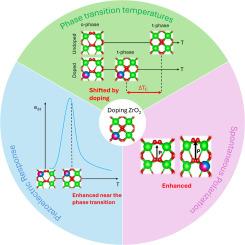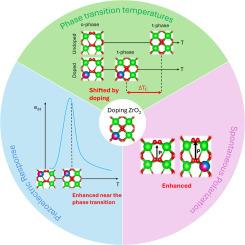掺杂对ZrO 2铁电和压电性能影响的从头算研究
IF 9.3
1区 材料科学
Q1 MATERIALS SCIENCE, MULTIDISCIPLINARY
引用次数: 0
摘要
铁电二元氧化物在能量存储、非易失性存储器和神经形态计算设备中显示出巨大的应用前景。与半氧化铪(HfO2)相比,氧化锆(ZrO2)薄膜的研究近年来取得了重大进展。掺杂是一种很有前途的调节HfO2和HfxZr1-xO2 (HZO)铁电性质的工具。然而,掺杂对ZrO2结构和铁电性能影响的广泛研究仍然广泛缺失。本研究通过密度泛函理论(DFT)和自算分子动力学(AIMD)计算,研究了B、Si、Al、Mg、Sc、Ca、Ce、Ta、Hf、Y、Sr、La、Ba和Rb掺杂对ZrO2在3.125和6.25 cat%掺杂浓度下单斜相(m-)、极性正交相(o-)和四方相(t-)的结构畸变、相对相稳定性、相变温度、自发极化和压电响应的影响。结果表明,Si、B和Al的掺入可以显著提高ZrO₂的自发极化幅度,并且可以调节ZrO₂的相对相稳定性和相变温度。具体来说,我们的计算证实了Si掺杂促进了ZrO₂中t相的稳定。此外,我们发现掺杂改变了相变温度,导致压电响应的实质性改善,在al掺杂的ZrO₂中观察到高达7倍的增加。因此,这项工作强调了最有前途的能够提高ZrO₂薄膜铁电和压电性能的掺杂剂。本文章由计算机程序翻译,如有差异,请以英文原文为准。


Ab initio study of doping effects on the ferroelectric and piezoelectric properties of ZrO₂
Ferroelectric binary oxides show great promise for application in energy storage, non-volatile memories, and neuromorphic computing devices. Compared to hafnia (HfO2), zirconia (ZrO2) thin films have been understudied in spite of significant recent progress. Doping has emerged as a promising tool to tune the ferroelectric properties of HfO2 and HfxZr1-xO2 (HZO). However, an extensive study of the effects of doping on the structural and ferroelectric properties of ZrO2 is still widely missing. In this study, through density functional theory (DFT) and ab initio molecular dynamics (AIMD) calculations we investigate the effects of B, Si, Al, Mg, Sc, Ca, Ce, Ta, Hf, Y, Sr, La, Ba and Rb doping on the structural distortions, relative phase stability, phase transition temperatures, spontaneous polarization and piezoelectric response of the monoclinic (m-), polar orthorhombic (o-) and tetragonal (t-) phases of ZrO2 at 3.125 and 6.25 cat. % doping concentration. We demonstrate that the spontaneous polarization magnitude in ZrO₂ can be significantly enhanced through doping with Si, B, and Al. In addition, our results reveal that the relative phase stability and phase transition temperatures of ZrO₂ can be tuned by doping. Specifically, our calculations confirm that Si doping promotes the stabilization of the t-phase in ZrO₂. Furthermore, we show that doping shifts the phase transition temperature, leading to substantial improvements in piezoelectric response, with up to a sevenfold increase observed in Al-doped ZrO₂. Consequently, this work highlights the most promising dopants capable of enhancing the ferroelectric and piezoelectric properties of ZrO₂ thin films.
求助全文
通过发布文献求助,成功后即可免费获取论文全文。
去求助
来源期刊

Acta Materialia
工程技术-材料科学:综合
CiteScore
16.10
自引率
8.50%
发文量
801
审稿时长
53 days
期刊介绍:
Acta Materialia serves as a platform for publishing full-length, original papers and commissioned overviews that contribute to a profound understanding of the correlation between the processing, structure, and properties of inorganic materials. The journal seeks papers with high impact potential or those that significantly propel the field forward. The scope includes the atomic and molecular arrangements, chemical and electronic structures, and microstructure of materials, focusing on their mechanical or functional behavior across all length scales, including nanostructures.
 求助内容:
求助内容: 应助结果提醒方式:
应助结果提醒方式:


